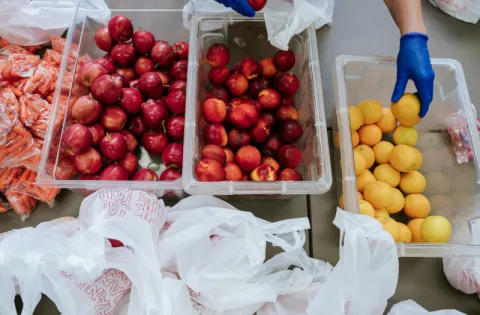In order to end childhood hunger in the United States, we have to understand that hunger may affect people and communities in ways we least expect.
What is Nutrition Security?
Nutrition security occurs when people have access to a variety of affordable food options they need to be healthy. In other words, families have nutrition security when there is an acceptable quantity of food that is also high-quality.
The physical symptoms of nutrition insecurity may not be visible, which can make it uniquely difficult to identify. It is often prevalent in low and middle-income communities where people may rely on a limited variety of staple foods that lack essential nutrients. Without access to varied food options, including nutrient-dense produce and other key components of a nourishing diet, the health and wellness of these families can suffer significantly.
Although people facing nutrition insecurity may have enough food to meet their basic needs, the lack of dietary diversity can still have serious health consequences (especially for children and pregnant women). Poor health outcomes that are linked to food and nutrition insecurity are more likely to impact communities of color, contributing to the vast inequities faced by historically underserved populations today. Increasing nutrition security can help us take positive steps toward health equity in America.
Ways Hunger Happens in Communities
So, how does nutrition insecurity happen? Unfortunately, it can occur far more easily than you might think - here’s how.
Food Accessibility
There are geographic areas where people have limited access to affordable, healthy, and nutritious food options, such as fresh fruits, vegetables and whole grains. These are often areas that are home to people who were historically treated unfairly, so there may be few grocery stores or supermarkets and limited public transportation.
People living in these communities may largely rely on fast-food restaurants or convenience stores, where it is difficult to find high-quality, nutritious options. These places offer mostly processed and high-calorie foods, leading to a higher risk of diet-related diseases, such as obesity, diabetes, and cardiovascular disease.
Food Costs
For families that are struggling to make ends meet, the increasing food prices and costs of groceries can make it even more difficult to stock up on nutritious foods. As a result, they may find themselves choosing low-cost options that lack nutritional value, or they may only be able to purchase the basics without any additional items such as produce, meats, and so on.
How Nutrition Insecurity Can Be Alleviated
To successfully address nutrition insecurity, we need to work together to tackle the issue with a multifaceted approach. This means focusing on improving access to a diverse range of nutritious food and expanding public awareness and nutritional education.
Here are a few of the strategies we’re using to zero in on this issue in communities across the U.S.
Community Engagement
When people within the community join the fight against hunger, it can make a world of difference for children and families. In order to achieve nutrition security, it is essential to work with communities to understand and address the barriers to accessing healthy foods.
School & Community Meals
School can be an excellent place for children to get nutritious meals, which is why we work so hard to fund school meal programs. When schools provide kids with breakfast, lunch and afterschool meals, children get the healthy food they need to learn, grow and thrive.
Free Meals Finder
The Free Meals Finder makes it easy for families to locate community organizations serving no-cost, nutritious meals in their area. With just a few clicks - or even a text message - they can find food pantries, food banks, and other options.
Ways You Can Help - Partner With No Kid Hungry Today
We can all do our part to end childhood hunger in the United States. But millions of kids are living with hunger right now. By partnering with us at No Kid Hungry, you can help change that.
Whether it’s donating your time or money, or joining the conversation as an advocate for children, there are many different ways you can make a difference in the fight against hunger. Together, we can work toward putting an end to child hunger in the U.S. Click here to get more information about how to partner with No Kid Hungry and start taking action today!
Image Credit: Irina Wilhauk / Shutterstock



